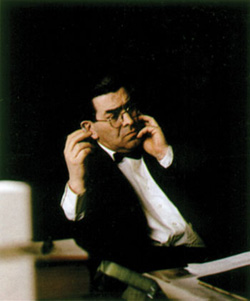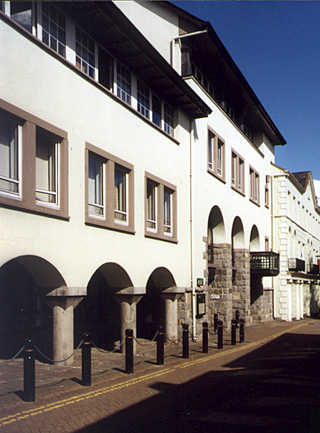Biography
The Dewi-Prys Thomas Trust commemorates a man who had a profound influence on architecture and town planning in Wales. His direct influence was that of a distinguished practitioner.
Perhaps even more important was the indirect influence that he exercised as a designer, lecturer and critic dedicated to the culture and heritage of Wales. He was the very first professor of architecture in the history of the University of Wales and, during his time as Head of the Welsh School of Architecture, he also brought into existence a new and separate Department of Town Planning.
Dewi-Prys Thomas was born in Liverpool in 1916 into a very Welsh family. His early years in that noble English seaport full of fine buildings were ‘… entirely spent within a circle of about a mile in radius’. This may have been his physical domicile, but his spiritual home lay beyond the Wirral in the mountainous land of his ancestors. Initially intent on becoming an artist, his brilliant draughtsmanship caught the eye of Roscoe Professor Lionel Budden who pressured him instead into reading architecture at the University of Liverpool. From here in 1939 he graduated with First Class Honours, the culmination of an astonishing prize-winning progress. He then went on to study town planning under William Holford.
For seven years he worked with Cardiff architects, amongst them T Alwyn Lloyd with whom he helped to develop the Alwyn Lloyd and Herbert Jackson South Wales Outline Plan. Then, in 1947, he was invited back to the Liverpool School of Architecture to join the staff, and become a senior lecturer. He remained there until he was appointed Head of the Welsh School of Architecture in 1960, the post which he occupied until his retirement in 1981.
During his time in Liverpool he also set up in private practice, and attracted commissions that gave him the opportunity to create new buildings notable for their freshness of design, meticulous and practical detailing, and always imbued with a sense of time and place. Several examples of his inspirational yet functional works of architecture survive. One such building in the suburbs of Liverpool attracted the Women’s Journal ‘House of the Year Award’ in 1960, and was described by Quentin Hughes as ‘… a little gem of a house, lovingly detailed’. But the increasing demands of his rigorous commitment to academic duties obliged him to forego the chance to further create architecture and, instead, he chose to help create architects for the Wales of the future. In one sense, in terms of what might have been, the architecture of Wales lost out. Nevertheless, after his retirement from the School, and although dogged by ill-health, Dewi-Prys Thomas once again demonstrated his wizardry in the designs for ‘Y Pencadlys’, the headquarters of Gwynedd County Council at Caernarfon. With its timeless quality, wit and humanity, this building serves as a monument to his creative skills.
As a lecturer and tutor Dewi-Prys Thomas was an inspiration to students from so many parts of the world. Naturally, he was bilingual and had a masterly command of both languages. He was a powerful communicator, thorough in his researches, perceptive and persuasive in his argument, and dramatic in his style of presentation. Yet he always found time and patience to listen, and to encourage others by teasing out the good points in their submissions which until that moment they had not even realised were there!
His scholarship went out to a wider audience for he was an environmental crusader, and appeared on countless occasions to represent bodies such as Civic Trust Wales and the Council for the Protection of Rural Wales, in both of which he was a key figure. He was highly respected as a Commissioner for the Royal Commission on the Ancient and Historical Monuments of Wales, and as a member of the Gorsedd of Bards.
Dewi-Prys Thomas was a man of vision, inspired from childhood by the writings of the eighteenth-century Welsh cleric and poet Ellis Wynne. In one work, ‘The Visions of the Sleeping Bard’, Wynne writes of making his way to the summit of a mountain, taking with him his spy-glass ‘… to help my weak sight to bring far things near and make small things larger’. Dewi-Prys Thomas himself possessed such an amazing power by which he brought events far away in time and place into a comparative present context, and revealed in seemingly small matters a significance hitherto undetected. Towards the close of his career (he died in 1985) he was moved to write, ‘observing Wales through my own architectural spy-glass I see … a vision of Wales radiant in her ‘Treftadaeth’ ... in her mountains and valleys, and the miraculous language and laughter of all her children … radiant in the heritage of all her towns, and little villages’.
For so many people Dewi-Prys Thomas was, and still is, a mentor and an archetype.
Englyn
Fe erys yng ngwaed ei Bencadlys
Y dewin-prin, Dewi-Prys.
Arfon Hughes
There remains in the weave of his Pencadlys,
the rare wizardry of Dewi-Prys.
